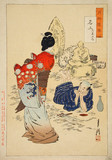From Wikipedia and Amy Reigle Newland "Rediscovering Ogata Gekkō" in "Printed and Painted: The Meiji Art of Ogata Gekkō (1859-1920), Leiden, Hotei Publishing, 2021, pp. 1-21. Ogata Gekkō was born as Nakagami Shōnosuke (名鏡 正之助) in Kyōbashi Yazaemon-chō in Edo (modern Tokyo) in 1859. His father, tradesman and rubbish recyler Nakagami Seijirō (名鏡 清次郎), died in 1876 leaving the family in poverty, and Gekkō took to work in a lantern shop in Kyōbashi Yumi-chō.
Gekkō was self-taught in art, starting by drawing from nature His early style shows the influence of the painter Kikuchi Yōsai, whose "Sage Ancestors, Ancient Matters (Zenkan kojitsu) of 1868 he accessed, its pages filled with portraits of heroes from Japanese myth and history. Having no entre into the art world, Gekkō determined to try woodblock printing. With a publisher, he began by creating scenes of current events, in particular the hot debate over whether to attack Korea when they refused to acknowledge the Meiji government in 1877. To spread his name recognition, he painted porcelain and did lacquer designs on rickshaws, also designing flyers for the pleasure quarters. Gekkō's designs on porcelains appeared in the 1881 Domestic Industrial Exposition.
About 1880-1881 he took the surname Ogata claiming to be a descendant of the ceramist Ogata Kenzan ostensibly given that designation by the head priest of Toranomon Kotohira Shrine. (see Newland p. 5). From around 1880, Gekkō was designing prints and illustrating books and newspapers, again concentrating on current events. In 1885 Gekkō exhibited in the Painting Appreciation Society, and he became acquainted with the art scholars Ernest Fenellosa and Okakura Kakuzō. That year also he was listed in "The Guidebook of Tokyo Fashion" as #7 out of 23 print artists, defining his career as that of a nishiki-e artist.
In 1886 Gekkō produced the print series Gekkō Zuihitsu (月耕随筆, "Gekkō’s Random Sketches"). In 1888, he married an art student of his, Tai Kiku—his second marriage—and changed his family name to Tai. He was a judge in the Japan Youth Painting Association [ja], which he helped found in 1891. The First Sino-Japanese War was the subject of a number of triptychs he designed in 1894–95.[1]
From the 1890s Gekkō won a number of art prizes, both national and international. He was one of the earliest Japanese artists to win international attention. At the World's Columbian Exposition in Chicago in 1893 he won a prize for Edo Sannō matsuri (江戸山王祭, "Edo’s Sannō Festival"), and in 1904 he won the Gold Prize for the series Fuji hyakkei (富士百景, "One Hundred Views of Mount Fuji") at the Louisiana Purchase Exposition.[1] His work was exhibited at the Exposition Universelle in Paris in 1900 and at the Japan-British Exhibition in London in 1910.[2][1] In 1898 at the Japan Art Association, Emperor Meiji bought his painting Soga yo-uchi (曽我夜討, "Night Attack of the Soga"). He won third prize at the sixth Ministry of Education Art Exhibition [ja] in 1912.[1]
Gekkō died on 1 October 1920 in Shin-Ogawamachi in Ushigome Ward of Tokyo at age 61. His art names include Kagyōrō, Meikyōsai, Kiyū, and Rōsai. He had few students, the best-known of whom was Kōgyo Tsukioka, the adopted son of Yoshitoshi.


